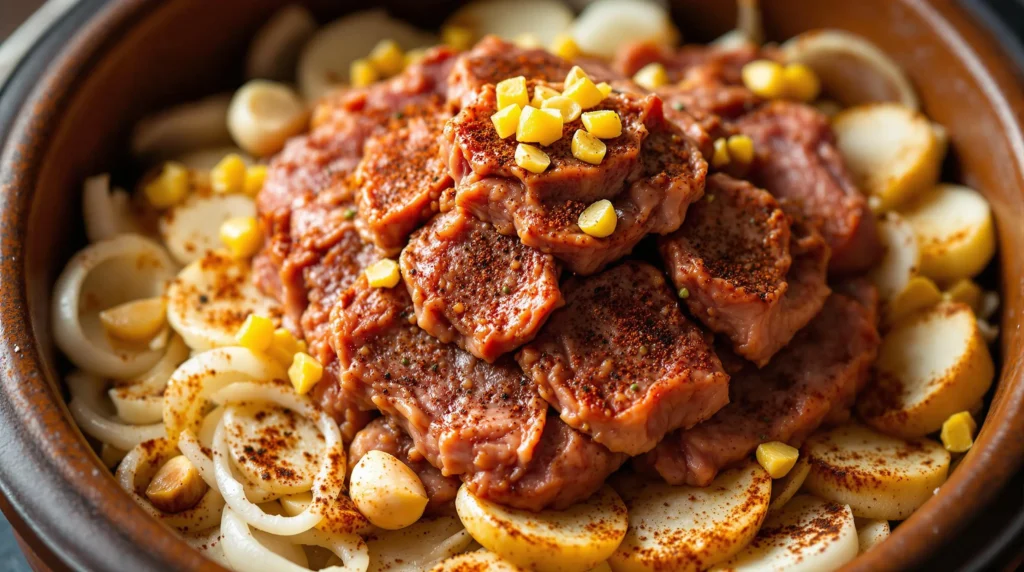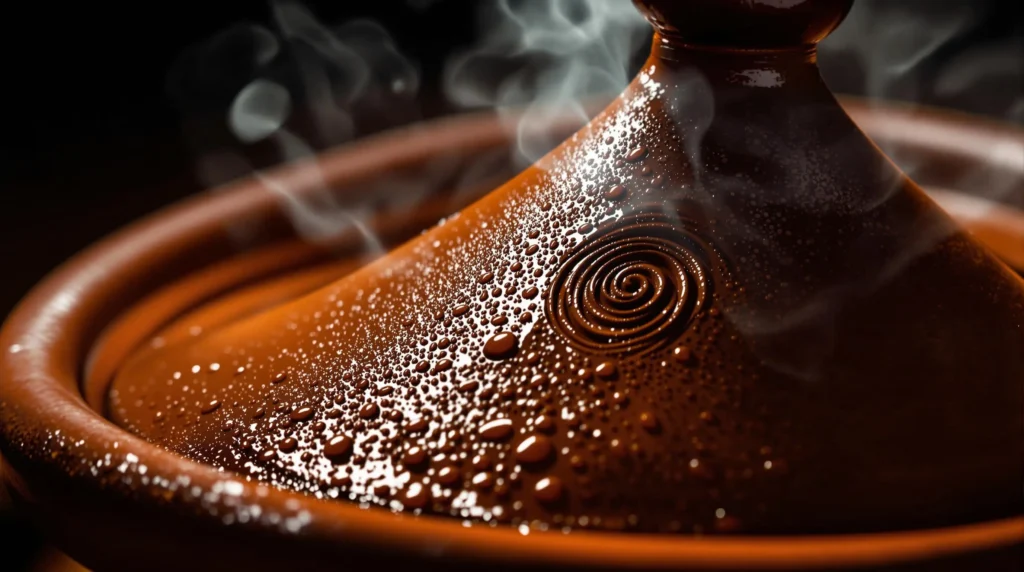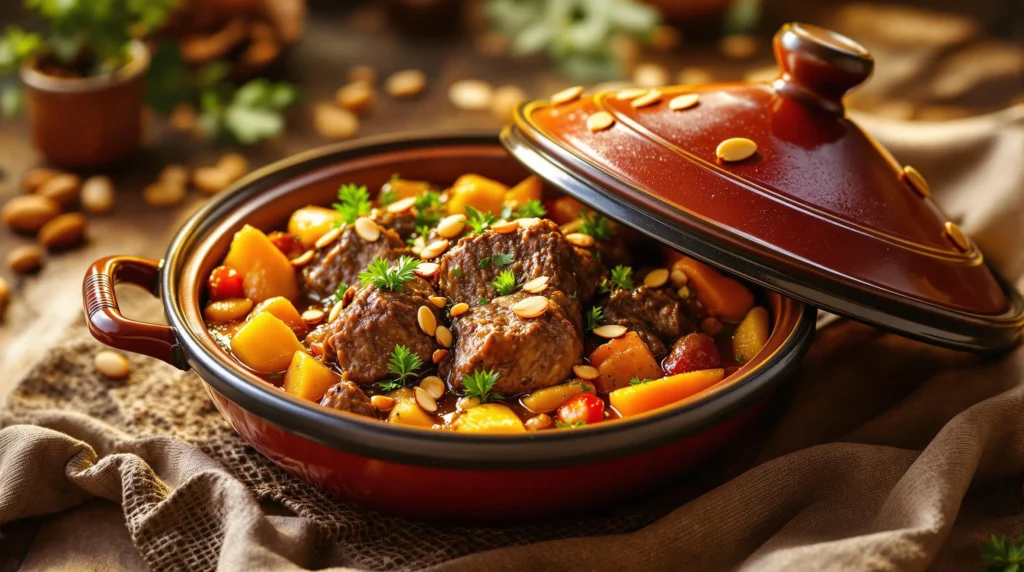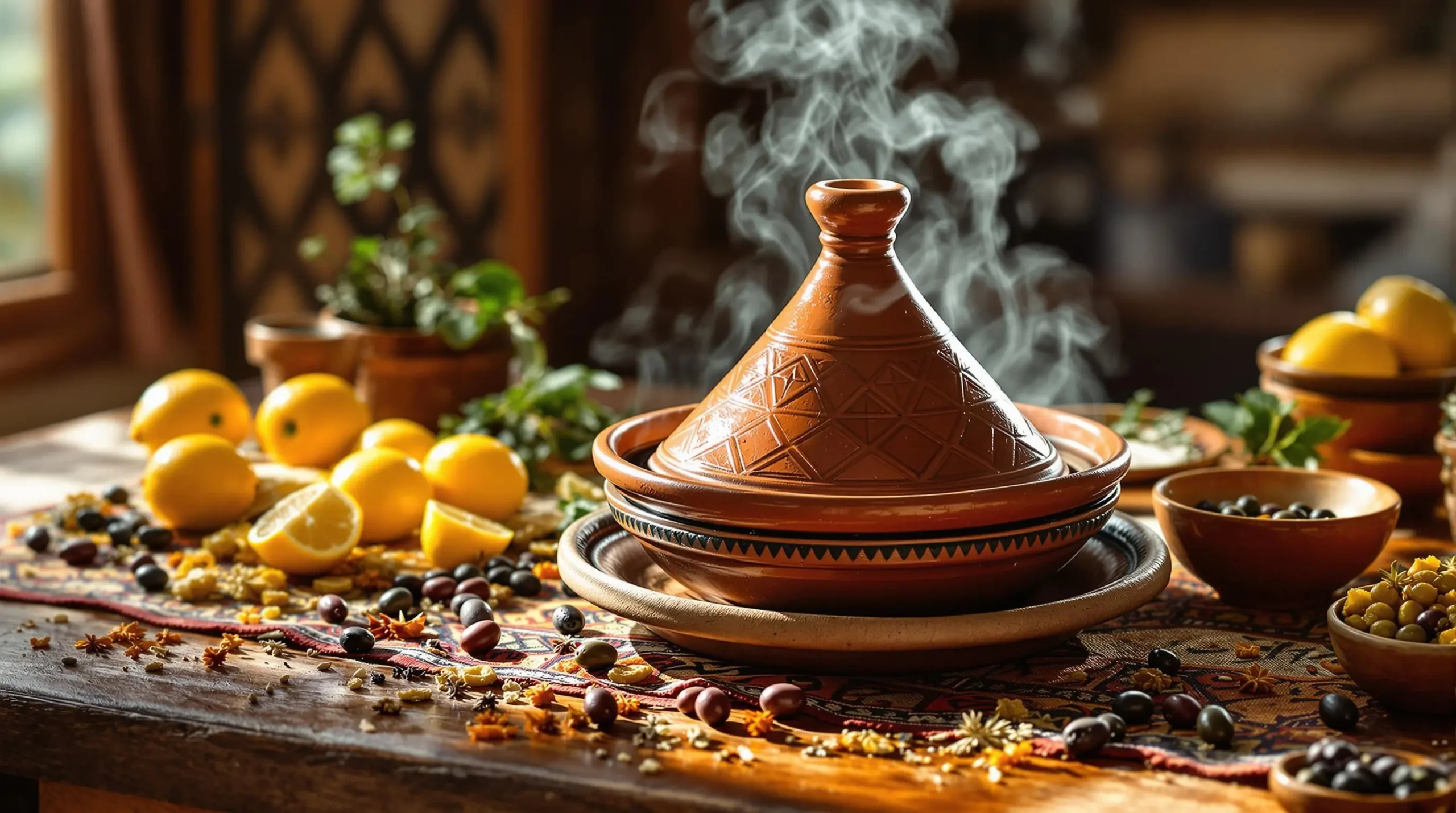Discovering Moroccan Tajine Traditions
Mastering the Moroccan Tajine Experience
Step into the vibrant world of Moroccan cuisine, where the gentle simmer of a Moroccan tajine tells stories passed down through generations. This iconic clay pot, with its distinctive cone-shaped lid, has been the cornerstone of North African cooking for centuries, transforming simple ingredients into masterpieces of flavor and tenderness.
At its heart, the beauty of Moroccan tajine cooking lies in its simplicity and genius design. The unique shape of the vessel works like nature’s perfect slow cooker – the cone lid captures rising steam, creating a continuous cycle of moisture that gently bastes the ingredients below. As a result, even the most humble cuts of meat become remarkably tender, while vegetables absorb the rich, aromatic sauce.
Moroccan tajine the essence of moroccan hospitality
Moreover, tajine cooking embodies the essence of Moroccan hospitality. Traditionally served directly from the cooking vessel, it creates an intimate dining experience where family and friends gather around to share not just a meal, but moments of connection. The anticipation builds as the lid is lifted, releasing a cloud of fragrant steam that promises the delights within.
Whether you’re using a traditional clay pot or a modern adaptation, mastering the art of tajine cooking opens doors to endless culinary possibilities. From classic lamb with preserved lemons to vegetable medleys with warming spices, each recipe carries the soul of Moroccan cuisine. Let’s explore the essential ingredients and techniques that will help you create these memorable dishes in your own kitchen.
Understanding the Tajine: History and Equipment
Origins and Cultural Significance
The story of the Moroccan tajine stretches back over a thousand years to the Berber communities of North Africa. These ingenious cooks developed the distinctive cooking vessel to make the most of limited fuel while creating flavorful, tender dishes. As trade routes expanded across the Maghreb region, the tajine’s popularity grew, absorbing influences from Arab, Andalusian, and Mediterranean cultures along the way.
Furthermore, the tajine evolved beyond mere cookware to become a symbol of Moroccan hospitality. When guests arrive, the ritual of gathering around a steaming Moroccan tajine creates an atmosphere of warmth and welcome. This tradition continues today, whether in bustling Marrakech restaurants or family homes throughout Morocco.
The Traditional Tajine Pot
At first glance, a traditional tajine pot might seem simple, but its design represents centuries of refinement. The shallow base, called the gsaâ, works together with the distinctive cone-shaped lid, known as the kefa, to create a remarkable cooking environment. As heat rises, the dome captures steam and redirects it back down, continuously basting the ingredients below.
The clay construction plays a vital role in the cooking process:
- Unglazed terracotta absorbs and releases moisture gradually
- The porous nature of the clay enhances flavor development
- Natural materials provide gentle, even heat distribution
While traditional clay pots remain the gold standard, modern versions made from cast iron, ceramic, or stainless steel offer practical alternatives for contemporary kitchens. However, many cooks insist that only traditional clay vessels can impart the authentic taste of a true Moroccan tajine.
Essential Equipment and Preparation
Before cooking your first tajine, proper preparation is essential. New clay tajines require seasoning to strengthen them and prevent cracking. This process involves:
- Soaking the pot in water for several hours
- Rubbing the inside with olive oil
- Slowly heating the pot to seal the clay
For successful tajine cooking, you’ll need:
- A heat diffuser for gas or electric stovetops
- Wooden utensils to protect the clay surface
- A sturdy trivet for serving
Caring for your tajine ensures it will last for years:
- Always let it cool completely before cleaning
- Use mild soap and warm water
- Never subject it to extreme temperature changes
- Store it in a dry place with good air circulation

Whether you choose a traditional clay pot or a modern adaptation, understanding these fundamentals helps preserve both the vessel and the authentic cooking techniques that make Moroccan cuisine so special. With proper care and attention, your tajine will become a treasured kitchen companion, ready to create countless memorable meals.
Authentic Moroccan Tajine Components
The heart of any Moroccan tajine lies in its carefully chosen ingredients and the artful way they come together. Understanding these essential components helps create dishes that capture the true essence of Moroccan cooking.
Core Ingredients for Your Moroccan Tajine
Traditional meat selections form the foundation of many classic recipes. Lamb remains the most popular choice, particularly tender cuts like shoulder or leg, while chicken offers a lighter alternative. Additionally, beef and fish appear in regional variations, each bringing its own character to the dish.
The spice palette defines the soul of tajine cooking:
- Ras el hanout, a complex blend of up to 30 spices
- Cumin, coriander, and turmeric for earthiness
- Cinnamon and ginger for warmth
- Fresh herbs like cilantro and parsley
Moreover, aromatics play a crucial role:
- Preserved lemons add bright, complex flavor
- Garlic and onions create a savory base
- Olives contribute briny depth
- Dried fruits offer natural sweetness
Building Flavors
The magic of a Moroccan tajine emerges through careful preparation and layering. First, marination proves essential for developing depth. Meat typically rests with spices, garlic, and olive oil for several hours or overnight, allowing flavors to penetrate deeply.
When assembling the tajine, proper layering becomes vital:
- Onions and aromatics form the bottom layer
- Marinated meat sits in the center
- Vegetables arrange around the edges
- Garnishes rest on top
Furthermore, managing liquid ratios requires attention. Unlike Western stews, tajines use less liquid, typically starting with just 1/2 cup. The pot’s design naturally creates moisture through condensation, so adding too much liquid can dilute the flavors.
Common Tajine Combinations
Several classic pairings have stood the test of time. Chicken with preserved lemons and olives remains perhaps the most famous, combining bright citrus notes with briny olives and warm spices. Meanwhile, lamb with prunes and almonds showcases the characteristic sweet-savory balance of Moroccan cuisine.
For vegetarian options, consider:
- Root vegetables with chickpeas
- Mixed vegetables with couscous
- Eggplant and tomato combinations
- Squash and sweet potato medleys
Additionally, regional variations reflect local ingredients and preferences:
- Coastal areas feature fish tajines with chermoula
- Mountain regions prefer heartier meat versions
- Desert areas incorporate dates and nuts
- Urban centers offer modern interpretations
Through these combinations, each tajine tells its own story while maintaining the core principles that make this cooking style so beloved. By understanding these essential components, you’ll be better equipped to create authentic dishes that honor the rich traditions of Moroccan cuisine.
Mastering Moroccan Tajine Cooking Techniques
Understanding the fundamental techniques of Moroccan tajine cooking transforms simple ingredients into extraordinary dishes. Let’s explore the essential methods that bring out the best in this traditional cooking style.
Preparation Methods for Perfect Moroccan Tajine
The journey begins with proper ingredient arrangement, which proves crucial for even cooking. Start by creating a bed of sliced onions at the bottom of your tajine. Then, place the meat in the center, forming a pyramid shape that allows steam to circulate effectively. Subsequently, arrange vegetables around the edges, positioning harder vegetables closer to the heat source.
Temperature control plays a vital role in successful outcomes:
- Begin with a cold tajine on a low flame
- Gradually increase heat over 10-15 minutes
- Maintain a gentle simmer throughout cooking
- Never expose the pot to sudden temperature changes
Furthermore, cooking times vary depending on your ingredients:
- Lamb or beef: 2.5-3 hours
- Chicken: 1-1.5 hours
- Fish: 30-45 minutes
- Vegetable-only: 45-60 minutes
Traditional Serving Customs
The presentation of a Moroccan tajine involves more than just the dish itself. Traditionally, diners gather around the tajine, sharing the meal directly from the cooking vessel. This communal experience enhances the flavors with warmth and hospitality.
Essential accompaniments include:
- Fresh bread for soaking up sauce
- Couscous or rice as a base
- Simple salads with fresh herbs
- Mint tea to complement the meal
Moreover, modern presentation styles have evolved while respecting tradition:
- Individual serving plates for formal occasions
- Decorative garnishes like toasted almonds
- Fresh herb sprinkles before serving
- Colorful side dishes in separate bowls
Troubleshooting Common Challenges
Even experienced cooks encounter occasional issues when preparing tajine dishes. Understanding common pitfalls helps ensure consistent results:
First, avoid these frequent mistakes:
- Adding too much liquid initially
- Lifting the lid frequently during cooking
- Cooking at too high a temperature
- Overcrowding the tajine
Additionally, seasoning adjustments might be necessary:
- Taste and adjust spices 30 minutes before completion
- Add salt gradually throughout cooking
- Balance sweet and savory elements
- Incorporate fresh herbs at the end
For storage and reheating:
- Cool completely before refrigerating
- Store in airtight containers for up to 3 days
- Reheat gently on low heat
- Add fresh herbs after reheating
By mastering these fundamental techniques and understanding common challenges, you’ll be well-equipped to create authentic tajine dishes that capture the essence of Moroccan cuisine. Remember that practice leads to perfection, and each attempt brings you closer to mastering this time-honored cooking tradition.

Frequently Asked Questions About Moroccan Tajine
As you begin your journey into Moroccan tajine cooking, several common questions often arise. Let’s address these to help you create the perfect tajine dishes with confidence.
Can I cook tajine without a traditional clay pot?
Yes, you can certainly prepare tajine dishes without a clay pot. While traditional vessels offer unique benefits, you can use a heavy-bottom Dutch oven or deep skillet with a tight-fitting lid. However, keep in mind that you’ll need to adjust liquid amounts slightly upward since modern cookware doesn’t create the same moisture-retention environment as clay pots.
How long does a typical tajine take to cook?
Cooking times vary depending on your main ingredients:
- Lamb and beef: 2.5-3 hours
- Chicken: 1-1.5 hours
- Fish: 30-45 minutes
- Vegetables only: 45-60 minutes
Additionally, factors like meat cut size and vegetable thickness can affect cooking duration. Always ensure meat reaches proper internal temperature before serving.
What’s the difference between tagine and tajine?
Both spellings refer to the same dish and cooking vessel. “Tagine” represents the French-influenced spelling, while “tajine” follows Arabic transliteration. Moreover, both terms describe both the cooking pot and the dishes prepared in it. Either spelling is acceptable and commonly used.
Can I make vegetarian tajine?
Absolutely! Traditional Moroccan cuisine includes many meatless tajine recipes. Common vegetarian combinations include:
- Chickpea and root vegetable
- Seven-vegetable medley
- Eggplant and tomato
- Potato and olive
Furthermore, you can adapt most meat-based recipes by substituting vegetables or legumes while maintaining traditional spice blends.
How do I prevent my clay tajine from cracking?
To protect your clay tajine:
- Never expose it to sudden temperature changes
- Always start cooking on low heat
- Use a heat diffuser on modern stovetops
- Season new pots before first use
What should I serve with tajine?
Traditional accompaniments include:
- Fresh Moroccan bread
- Fluffy couscous
- Simple green salad
- Mint tea
These sides complement the rich flavors while following authentic serving customs.
Remember that practicing these techniques takes time, but each attempt brings you closer to mastering this beloved cooking style. Start with simple recipes and gradually work your way up to more complex combinations as your confidence grows.
Embracing the Spirit of Moroccan Tajine Cuisine
As we conclude our exploration of Moroccan tajine cooking, it’s clear that this centuries-old tradition offers far more than just a method of preparing food. The tajine represents a beautiful intersection of practical cooking wisdom and cultural heritage that continues to captivate food lovers worldwide.
Throughout this journey, we’ve discovered how the distinctive clay pot transforms simple ingredients into memorable dishes through its ingenious design. From the careful layering of ingredients to the patient simmering that develops deep flavors, each step in the process carries purpose and meaning. Moreover, the communal nature of tajine dining reminds us that great meals are about more than just sustenance – they’re about creating connections and sharing experiences.
Whether you choose to cook with a traditional clay pot or adapt these methods to modern cookware, the principles remain the same. Focus on:
- Building layers of flavor through careful ingredient selection
- Maintaining gentle heat for proper cooking
- Respecting the balance of spices and aromatics
- Creating an inviting atmosphere for sharing your creations
Furthermore, as you develop your tajine cooking skills, you’ll discover that each dish tells its own story – one that connects you to centuries of culinary tradition while allowing space for personal interpretation. This beautiful balance of honoring the past while embracing new possibilities makes tajine cooking a continuously rewarding culinary adventure.

Remember, the true essence of Moroccan cooking lies not just in the techniques and ingredients, but in the joy of sharing these aromatic, flavorful dishes with others. Let this ancient tradition inspire your modern kitchen, creating moments of warmth and connection around your table.

